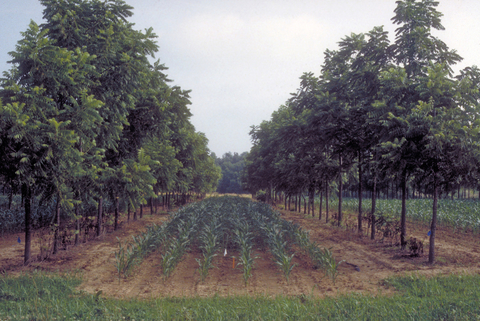Alley cropping is the planting of rows of trees or shrubs wide enough to create alleyways within which agronomic or forage crops are planted or produced.
Why practice alley cropping?
Alley cropping can have many ecological and economical benefits.
-
Reduced soil erosion. Especially when established in sloping areas, alley cropping can slow erosion, thereby improving water quality.
-
Improved crop performance. Added organic matter from trees and shrubs can increase soil productivity. Alley cropping also creates a microclimate from the increased shade and reduced wind, which in turn increases water use efficiency by crops.
-
Reduced use of chemical fertilizers and pesticides. Weeds are better controlled, and increased nutrient flow improves soil fertility without the use of fertilizers.
-
Minimized nitrogen leaching. Nitrogen leached beyond the cropping root zone is often captured by the deeper tree root systems. Minimizing this leaching improves water quality.
-
Promotion of biodiversity. Planting diverse vegetation provides more wildlife with more potential habitat.
Design considerations
When designing an alley cropping system, a landowner must consider a few things:
- Amount of rainfall.
- Compatibility of trees and shrubs with crops to minimize competition for water, nutrients, and light.
- Spacing between and within rows.
- Sun direction.
- Maintenance requirements and available equipment.
Establishing an alley cropping system
Alley cropping systems can be designed and established depending on the landowner objectives. There are several ways of establishing alley cropping systems:
- Convert existing orchard into an alley cropping system by integrating agronomic or forage crops. Thinning of the orchard maybe employed to allow for the establishment of alley cropping systems.
- Cultivate forage crops between rows of trees or shrubs, which can be used for cattle and livestock.
- Alternative perennial crops such as medicinal plants or Christmas trees within tall field crops such as corn.
For more information on alley cropping, we recommend the Training Manual for Applied Agroforestry Practices from the University of Missouri Center for Agroforestry.
Reviewed in 2018


